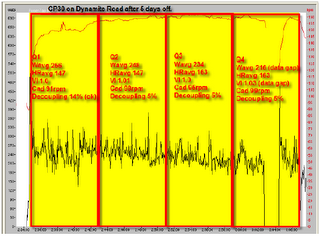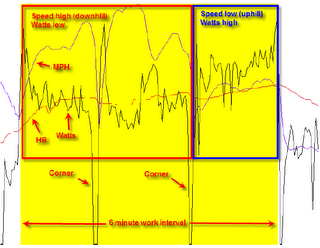Time Trial Pacing
What you don’t want to have happen in a time trial is to slow down gradually over the course of the event, “give up” and finish with a whimper. Yet this all too often happens. I’m afraid most athletes have too little patience and also believe that some how going our extra fast will lead to a better time than finishing fast. The problem is that when going out overly fast you create a lot of acid build up which causes you to slow at a greater rate than would have been the case had you been more conservative early on. In this graphic you can see what typically happens in a long TT. While this is a CP30 test the results are what normally happen when racing a TT. Note that the power line (black) descends throughout the 30 minutes while heart rate (red) rises. (There’s a 17-second gap near the right end where the device failed leaving a data gap.)
In this graphic you can see what typically happens in a long TT. While this is a CP30 test the results are what normally happen when racing a TT. Note that the power line (black) descends throughout the 30 minutes while heart rate (red) rises. (There’s a 17-second gap near the right end where the device failed leaving a data gap.)
Notice that I’ve divided the 30 minutes into four quarters with data on how each went. The average watts (“Wavg”) for each quarter clearly shows how power dropped while average heart rate (“HRavg”) rose, especially in the latter half. (The other data here is Variability Index (“VI”), cadence (“cad”), and decoupling (“dec”) which I won’t discuss now but have done in previous posts.)
I like to have the riders I coach divide the time trial course into four quarters just as I have done in the above graphic and have a strategy for each. Here is how I suggest they mentally manage each quarter of a longish time trial.
Q1. In the first they simply try to hold back. This will feel the easiest with RPE (Rating of Perceived Exertion) being the lowest of the race — and far lower than what their mind is telling them to do. This may only be a 3% reduction of power but it feels much greater. The tendency is to go out much too fast and pay the price later on. Heart rate will mean little here. RPE is everything, especially if you don’t have a power meter. If you start breathing hard here you went out much too fast.
Q2. In the second quarter, if you don’t have a power meter, heart rate and speed are watched closely. Realize that if it’s a windy day or a hilly course then speed means little. Power makes this so simple. Just ride at goal average power in quarter 2. If using a heart rate monitor and RPE stay in your goal average zone with an RPE which is only slightly harder than for the first quarter. Do not let heart rate rise above goal heart rate. Stay in tune with your technique and breathing while being careful not to get caught up in "racing" your minute man. Concentrate on your own race — not his or hers.
Q3. The third quarter is the toughest. If you will slow down, this is when it will happen. The purpose of the first half of the race is to prepare you for this section. If you controlled your effort and stayed in the moment earlier you will now be able to maintain average power, heart rate or speed here, altho it will now feel much harder. In other words, RPE is now rising rapidly even though your body is not working any harder than before. During this quarter you may well say to yourself, "I'm not doing very well. Going too slow. I'm going to get passed." That's normal. Expect it. Everyone will think that during this segment. Maintain focus and effort. Play "pedaling games." Count pedal strokes as "1-2-3-1-2-3, etc". On "1" apply more force and let up on "2-3". That means that each leg will get a 5-stroke "rest." Or try a 5-beat. Nearly 25 years ago in his book, Bicycle Racing, Eddie B. suggested pedaling with "only 1 leg" for a few strokes while the other "rests." Do whatever you need to mentally get through this section of the race. It is by far the toughest even if you paced properly earlier. If you didn’t then this part is incredibly depressing. You are likely to surrender to your minute man here.
Q4. In the fourth quarter you know there are only a few agonizing minutes left. The end is mentally in sight. It’s just like the horse smelling the barn – you feel capable of increasing the RPE. Now you can race others IF you held back in quarters 1 and 2. Try to gain on someone up the road. Concentrate on that target. With a couple of minutes to go begin to increase the effort gradually. Try to pass someone. Go hard, but if you can sprint you held back too much. You should finish feeling as if nothing was left on the course.
Mental preparation is critical to time trialing. Riders have told me of their "TT tricks," like imagining where they would be if they were on their interval course at home or "mentally" singing a song that has the right rhythm for their stroke. These may come in handy in quarter 3. When doing your time trial interval workouts (you’re doing these, aren’t you?) try doing four long intervals with each using the strategy you will employ for that quarter in the race. Don't wait until race day to practice this. Another element of successful time trialing that must be practiced is riding the hills so as to optimize performance. On all hills, including just small rollers you hardly even notice, ride slightly harder on the up side and slightly easier on the down side. This will help you gain time while giving your legs a small break. This also needs to be rehearsed when doing TT intervals. The accompanying chart illustrates how this was done. Here you can see a single six-minute interval from a workout. The early portion of this interval was slightly downhill as you can tell because speed (“MPH”) was high. So power was allowed to drop slightly here. In the latter half of this interval speed was low because of a slight uphill so the rider increased the power. Again, this should be rehearsed when doing time trial workouts.
Another element of successful time trialing that must be practiced is riding the hills so as to optimize performance. On all hills, including just small rollers you hardly even notice, ride slightly harder on the up side and slightly easier on the down side. This will help you gain time while giving your legs a small break. This also needs to be rehearsed when doing TT intervals. The accompanying chart illustrates how this was done. Here you can see a single six-minute interval from a workout. The early portion of this interval was slightly downhill as you can tell because speed (“MPH”) was high. So power was allowed to drop slightly here. In the latter half of this interval speed was low because of a slight uphill so the rider increased the power. Again, this should be rehearsed when doing time trial workouts.


13 Comments:
Joe
I was wondering I just did a vo2 and lactate test, I only went up to threshold, but I was wondering at what percent of a RER of 1.0 is to vo2max.I was at 4.4liters.(3min stages 25 watts) I was also curious what would a elite triathlete or cyclist be at for a 70kg guy at a RER of 1.0 just curious to see where I stand. thanks
sam
I know this is off topic with cycling. Would you consider for runners racing a marathons or half marathons to break them up into four segments just like in a Bike TT? Someone could you use a speed/gps device to pace the different portions of the race with a strategy for each portion?
shane--Yes, I think a running race should be approached much the same way. GPC/accelerometers are not as precise as power meters so this may not work well. They don't allow for hills, running surface and wind as power meters do. Some day there will be a power meter for runners.
Joe,
Could you explain: "Play "pedaling games." Count pedal strokes as "1-2-3-1-2-3, etc". On "1" apply more force and let up on "2-3". That means that each leg will get a 5-stroke "rest." Or try a 5-beat." in a different way? I am not sure if I have really understood how to do it.
Thanks..Fabiano.
Fabiano--In the example you would count every pedal stroke in sets of three: 1 (left), 2 (right), 3 (left), 1 (right), 2 (left), 3 (right), etc. Every time you say "1" apply more power. Apply less power on 2-3.
Humm...Thanks Joe. I got it.
is it the same principle to a climbing time trial? If the climb is relative steady gradient.
Ron--No, as wind speed is usually not an issue when climbing. That's why you back off on slight downhills and go harder on slight uphills.
Joe,
You mean the pacing strategy (Q1-Q4) can not be fully apply to the pure climbing time trial?( ex: 20KM only slightly flat to up hill). Just like you say, maybe climbing is just a art, nobody can exact tell you when you need acceralate and elevate your power and when it's time to slightly slow down. Right? Or maybe it just need to work hard all the time when climb.
If doing a TT with a power meter would you recommend pegging it at FTP from the gun for a 1-hr TT, or riding below FTP in the first quarter and then ramping up to finish slightly above FTP? If the first quarter of a TT should feel easy, I'm guessing that's below FTP.
Anon--If the course was flat and there was no wind (never happens, right?) you'd want to negative split the course which means slightly lower going out and slightly higher coming back. Averaging FTP would be the result.
Joe, I happened to come across your pacing article about two days before the Crank the Kanc time trial in Conway, NH. The race is 16.5 miles gradual uphill, and the last 4.5 miles is an average grade of just over 6%. Even with the climb, the race warrants the TT bike. But for me, this was a long race with a goal time of 1:20:00. Having read your article I broke up my TT as follows, given FTP of 265:
1st quarter - 230-240 watts (actual = 244)
2nd quarter - 240-250 watts (actual = 248)
3rd quarter - 250-260 watts (actual = 257)
4th quarter - threshold/265 (actual = 265)
This strategy worked out extraordinarily well, and I had enough in the tank to push threshold pace on the climb, while remaining fast and aero on the lower portions of the slopes.
Came in at 1:16:41, well below goal.
Thanks for the tip!
This article is fantastic. I've bookmarked it. I should really print it out and put it on the wall. Thanks!
Post a Comment
<< Home